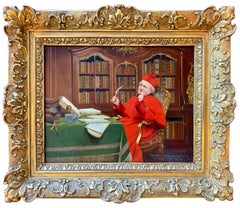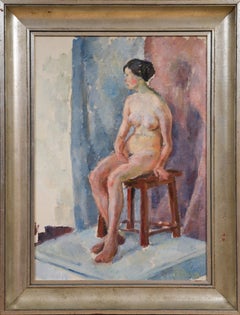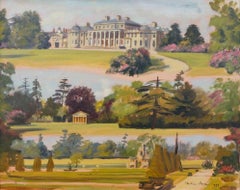Shugborough Park
by Julian Barrow, British 1939-2003
signed and dated 1973
oil painting on canvas, framed
canvas: 16 x 20 inches
framed 19.5 x 24 inches
Beautiful oil painting by the famous British painter, Julian Barrow (1939-2003). The painting depicts three views of the Shugborough Estate in Staffordshire, which is now owned by the National Trust.
A prolific traditionalist, he painted almost 1,000 country seats, great and small, across the world, in a style that was reassuringly conventional but not dull ; he always made maximum use of lighting effects. According to Auberon Waugh, Barrow had “a peculiar genius for capturing the Englishness of a building, its social and architectural essence”.
Though he never possessed a pinstriped suit, Barrow was once described in this newspaper as “far happier in a Savile Row suit than a dirty artist’s smock”. Tall, slim, soldierly, gentle, humorous and self-mocking, he lived and worked for almost 50 years in the studio in Tite Street, Chelsea, which had been occupied by Sargent and Augustus John.
He captured the Albert Bridge from every angle, at high and low tide, and made frequent excursions further afield. In St James’s Street, he painted posh shopfronts like Lock & Co and Berry Brothers with characteristic aplomb, but was sometimes even more excited by humble front doors and casement windows in Spitalfields.
Much though he loved his own country, Barrow was equally at home in America, where he held several successful one-man exhibitions – capturing Grand Central Station with as much zest as he did the Grand Canal in Venice.
in early 1960 went to Florence to become a student of Pietro Annigoni, already famous for his early portrait of the Queen. For the next few years he divided his time between London and Florence.
In May 1961 he rented his first studio in Tite Street, across the road from the building that would later become his permanent home. Here he was commissioned by the King’s Own Scottish Borderers to paint their star soldier, Sgt Bill Speakman, VC; and in August that year, on hearing of the theft of Goya’s Duke of Wellington from the National Gallery, he perpetrated the prank of his life. Quickly dashing off a copy of the famous portrait, Barrow carried it through Trafalgar Square, casually tucked under his arm, ill-disguised by old newspapers and exciting the attention of the crowds — and the police.
In 1965 he drove through Lebanon, Syria and Jordan to Jerusalem, where he completed a portrait of the Anglican archbishop, a cousin of his mother, and held an impromptu exhibition to finance his drive home via Turkey and Greece. The following year he was in New York, holding his first one-man show and painting Mrs Vincent Astor in her Manhattan drawing room.
By 1971, when he married Serena Harington, Barrow’s popularity as an artist was well established. Later described by James Lees-Milne as “a country house painter par excellence”, he had already done Colin Tennant’s Scottish home, Glen; Castle Howard in Yorkshire; and Shugborough Hall in Staffordshire. He was soon painting hundreds of other stately piles. He would often add his own private jokes to these pictures: a majestic landscape of Rokeby Park, Co Durham, included – if you looked carefully enough – a vignette of the Rokeby Venus, the lady once described as having the most slappable bottom in the National Gallery.
At the same time Barrow was producing innumerable interiors and conversation pieces, revealing the essential characters of his sitters (some admirers thought them subtle caricatures) by showing them surrounded by all their personal clutter. Early works included the Malcolm Forbes family in New Jersey, the Duc and Duchesse Decazes at the Palazzo Polignac in Venice, and a boardroom scene at Purdey, the Mayfair gunsmiths. These were followed by portraits of Auberon Waugh – wine bottle to hand – at his desk at Combe Florey, and James Lees-Milne in his garden at Badminton.
In 1977, for the Queen’s Silver Jubilee, he produced a portrait of the House of Lords which now hangs at Westminster and embarked on a series of interiors of London clubs such as the Garrick and Beefsteak . He continued to travel the world, and trips to India’s forts and palaces became an annual event . When abroad he was as happy sleeping in some rat-infested bed in the wilds as in the luxury B&B at Tikli Bottom, near Delhi .
In 2011 Barrow and his wife celebrated their 40th wedding anniversary by spending the night at London’s Savoy Hotel. The room once used by Monet overlooking the river was not available, but they were upgraded to the Charlie Chaplin suite, from which Barrow produced five riverscapes in 24 hours.
Barrow’s work has been praised over the years by a number of commentators, including John Julius Norwich, who once wrote: “Julian Barrow’s pictures convince us that whatever terrible things happen in the world there is beauty aplenty for the asking – and for the taking.” Several years ago he even extracted mild words of praise from the hard-to-please Brian Sewell: “The marmalade glow of Julian Barrow’s autumn is almost tolerable.”
Shugborough Hall is a stately home near Great Haywood, Staffordshire, England.
The hall is situated on the edge of Cannock Chase, about 4 miles (6.4 km) east of Stafford. The estate was owned by the Bishops of Lichfield until the Dissolution of the Monasteries, upon which it passed through several hands before being purchased in 1624 by William Anson, a local lawyer and ancestor of the Earls of Lichfield. The estate remained in the Anson family for three centuries. Following the death of the 4th Earl of Lichfield in 1960, the estate was allocated to the National Trust in lieu of death duties, and then immediately leased to Staffordshire County Council. Management of the estate was returned to the National Trust in 2016. It is open to the public and comprises the hall, museum, kitchen garden and a model farm.
The Shugborough estate was owned by the Bishops of Lichfield until the Dissolution of the Monasteries around 1540, and thereafter passed through several hands, until it was purchased in 1624 by William Anson (c.1580–1644), a lawyer, of Dunston, Staffordshire for £1,000. In 1693, William Anson's grandson, also called William (1656–1720), demolished the existing manor house and constructed a three-story building which still forms the central part of the hall.
William's elder son, Thomas Anson MP (1695-1773), would further extend the house in the 1740s, adding two pavilions flanking either side of the central block. It was Thomas's younger brother, however, who would fund these changes; Admiral George Anson, created Lord Anson in 1747 and First Lord of the Admiralty in 1751, amassed a great fortune during his naval career, and when he died without issue he left the majority to his elder brother. Thomas also died childless and the estate passed to his sister's son, George Adams, who adopted the surname Anson by royal licence.
In 1806, George's son Thomas (1767–1818) was created 1st Viscount Anson. His son, the 2nd viscount, would be created 1st Earl of Lichfield in the coronation honours of William IV. The Earl led an extravagant lifestyle and amassed several large debts, which, in 1842, forced him to sell the entire contents of the house in a two-week-long sale. While the 2nd earl did much to restore the house and contents to its former glory, by the time his son inherited the estate it was heavily mortgaged.
In 1831, Princess Alexandrina Victoria of Kent, the future Queen Victoria, then 13, visited Shugborough with her mother, the Duchess of Kent, as part of an extensive tour of the country. The young princess stayed with many local landowners at the time, including the Earl of Shrewsbury.
Shugborough Tunnel - postcard, 1900s
Passing from east to west through the southern part of the park is the Trent Valley Line, planned in 1845. The railway is carried under the landscaped grounds in a 776-yard (710 m) tunnel and is thus largely invisible. The tunnel entrances, which are listed grade II, are notably ornamental, particularly the 1847 western entrance. An elegant stone bridge, also from 1847 and also listed grade II, about 380 yards (350 m) north-west of the Lichfield Lodge, carries the drive to the Hall over the railway. The double-track line is part of the West Coast Main Line, running north-west between Colwich Junction and Stafford.
Following the death of the 4th earl in 1960, an agreement was reached whereby the estate would pass to the National Trust in lieu of death duties. The deal was finalized and the house opened to the public in 1966. The estate was immediately leased to Staffordshire County Council, who managed and maintained it on behalf of the National Trust, with
Lord Lichfield...


